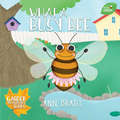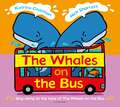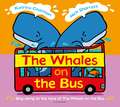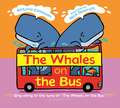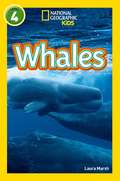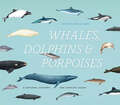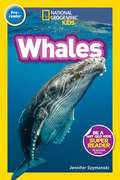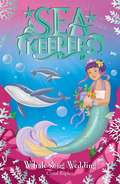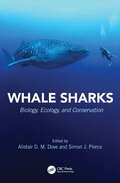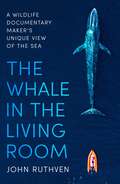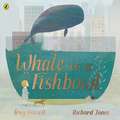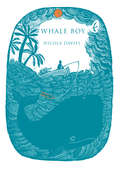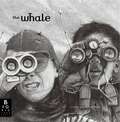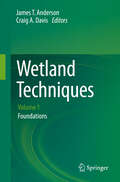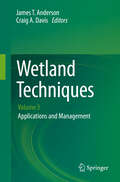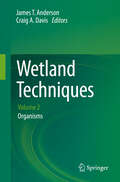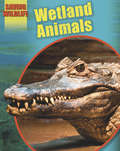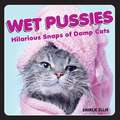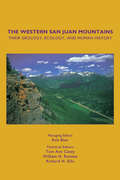- Table View
- List View
What a Submarine Sees: A fold-out journey under the waves
by Laura KnowlesThis charming concertina book follows the journey of a little submersible on a voyage beneath the waves, down into the deep dark ocean and back again. Folding out to nearly 2.5 metres, children can look at all the different things the sub sees on its way, as it travels past a shipwreck, through a coral reef, near to a pod of orcas hunting for their lunch, close to a leatherback turtle feasting on jellyfish, and past some rather strange deep-sea fish. Playful text guides the journey, providing a fun shared experience and a conversation starter for parents and young children.The reverse side of the concertina features spot illustrations picked out from the main scene, with more expansive information about submarines, ocean life and the dangers it is facing.
What a Busy Bee (Little Friends: Garden Adventures Series #2)
by Ann BradyOne sunny day Bella Bee flies into the garden. Jenny Wren hears her buzzing and comes out of the bird box to find out what Bella is doing. Bella tells Jenny she is going to make honey. Bella and the other bees in the bee hive are very good at making honey. But to do this they have to collect lots of nectar. There are lots of different flowers growing around the garden and Bella Bee must decide which ones to collect pollen from. Once filled up with nectar, Bella Bee falls asleep but is woken up by Kitty Cat before the rain starts.
The Whales on the Bus
by Katrina CharmanCranes on trains? Goats on boats? Dragons on wagons? Join in the fun with a host of colourful animals as they ride, soar, whizz and zoom on a whole range of exciting vehicles … from tigers on gliders to ducks on trucks. Add to that a text to read aloud to the tune of 'The Wheels on the Bus' and … What a combination!The whales on the bus ride round the town, Round the town, round the town. The whales on the bus ride round the town,All day long!Jam-packed with things on wheels and a whole lot of crazy creatures, this zany adventure provides endless fun for fans of planes, trains, cars, buses and animals of all kinds! Little ones will love singing along to the tune of a favourite nursery rhyme, with bold, colourful illustrations by the instantly recognisable Nick Sharratt and text by the talented Katrina Charman.
The Whales on the Bus
by Katrina CharmanCranes on trains? Goats on boats? Dragons on wagons? Join in the fun with a host of colourful animals as they ride, soar, whizz and zoom on a whole range of exciting vehicles … from tigers on gliders to ducks on trucks. Add to that a text to read aloud to the tune of 'The Wheels on the Bus' and … What a combination!The whales on the bus ride round the town, Round the town, round the town. The whales on the bus ride round the town,All day long!Jam-packed with things on wheels and a whole lot of crazy creatures, this zany adventure provides endless fun for fans of planes, trains, cars, buses and animals of all kinds! Little ones will love singing along to the tune of a favourite nursery rhyme, with bold, colourful illustrations by the instantly recognisable Nick Sharratt and text by the talented Katrina Charman.This audio-enabled edition comes with a gorgeous reading by Sam Newton, along with music and sound effects.
The Whales on the Bus
by Katrina CharmanSet to the tune of The Wheels on the Bus, this zany adventure provides endless fun for fans of planes, trains, cars, buses, and animals of all kinds!The whales on the bus ride round the town, Round the town, round the town. The whales on the bus ride round the town, All day long! Join in the fun with a host of colorful animals as they ride, soar, whizz and zoom on a whole range of exciting vehicles--from tigers on gliders to cranes on trains and ducks on trucks. Don't miss these Amazon Best Books of the Year!Car, Car, Truck, JeepGo, Go Pirate Boat
The Whales on the Bus
by Katrina CharmanSet to the tune of The Wheels on the Bus, this zany adventure provides endless fun for fans of planes, trains, cars, buses, and animals of all kinds!The whales on the bus ride round the town, Round the town, round the town. The whales on the bus ride round the town, All day long! Join in the fun with a host of colorful animals as they ride, soar, whizz and zoom on a whole range of exciting vehicles--from tigers on gliders to cranes on trains and ducks on trucks. Don't miss these Amazon Best Books of the Year!Car, Car, Truck, JeepGo, Go Pirate Boat
Whales: Level 4 (PDF)
by Laura Marsh National Geographic Kids StaffNational Geographic Primary Readers pair magnificent National Geographic photographs with engaging text by skilled authors to help your child learn to read. Developed by education experts, this series of books for beginner readers is spread across four levels: Early Reader, Becoming Fluent, Becoming Independent and Independent Reader. Did you know that over the course of their 70-year life span, sperm whales will easily travel the circumference of the Earth in search of food? Along the way, these massive beasts battle 30-feet-long giant squids, and each other, in order to sustain their ways of life. Find out all about the life journey of sperm whales in this fascinating and carefully levelled National Geographic Kids Level 4 photographic book. Level 4: Independent Reader books are perfect for kids who are reading on their own with ease and are ready for more challenging vocabulary with varied sentence structures. They are ideal for readers of White and Lime book bands for guided reading.
Whales, Dolphins, and Porpoises: A Natural History and Species Guide
by Annalisa BertaThe eighty-nine cetacean species that swim our seas and rivers are as diverse as they are intelligent and elusive, from the hundred-foot-long, two-hundred-ton blue whale to the lesser-known tucuxi, ginkgo-toothed beaked whale, and diminutive, critically endangered vaquita. The huge distances these highly migratory creatures cover and the depths they dive mean we catch only the merest glimpses of their lives as they break the surface of the water. But thanks to the marriage of science and technology, we are now beginning to understand their anatomy, complex social structures, extraordinary communication abilities, and behavioral patterns. In this beautifully illustrated guide, renowned marine mammalogist Annalisa Berta draws on the contributions of a pod of fellow whale biologists to present the most comprehensive, authoritative overview ever published of these remarkable aquatic mammals. Opening with an accessible rundown of cetacean biology—including the most recent science on feeding, mating, and communication—Whales, Dolphins, and Porpoises then presents species-specific natural history on a range of topics, from anatomy and diet to distribution and conservation status. Each entry also includes original drawings of the species and its key identifiers, such as fin shape and color, tooth shape, and characteristic markings as they would appear both above and below water—a feature unique to this book. Figures of myth and—as the debate over hunting rages on—figures of conflict since long before the days of Moby-Dick, whales, dolphins, and porpoises are also ecologically important and, in many cases, threatened. Written for general enthusiasts, emergent cetacean fans, and biologists alike, this stunning, urgently needed book will serve as the definitive guide for years to come.
Whales, Dolphins, and Porpoises: A Natural History and Species Guide
by Annalisa BertaThe eighty-nine cetacean species that swim our seas and rivers are as diverse as they are intelligent and elusive, from the hundred-foot-long, two-hundred-ton blue whale to the lesser-known tucuxi, ginkgo-toothed beaked whale, and diminutive, critically endangered vaquita. The huge distances these highly migratory creatures cover and the depths they dive mean we catch only the merest glimpses of their lives as they break the surface of the water. But thanks to the marriage of science and technology, we are now beginning to understand their anatomy, complex social structures, extraordinary communication abilities, and behavioral patterns. In this beautifully illustrated guide, renowned marine mammalogist Annalisa Berta draws on the contributions of a pod of fellow whale biologists to present the most comprehensive, authoritative overview ever published of these remarkable aquatic mammals. Opening with an accessible rundown of cetacean biology—including the most recent science on feeding, mating, and communication—Whales, Dolphins, and Porpoises then presents species-specific natural history on a range of topics, from anatomy and diet to distribution and conservation status. Each entry also includes original drawings of the species and its key identifiers, such as fin shape and color, tooth shape, and characteristic markings as they would appear both above and below water—a feature unique to this book. Figures of myth and—as the debate over hunting rages on—figures of conflict since long before the days of Moby-Dick, whales, dolphins, and porpoises are also ecologically important and, in many cases, threatened. Written for general enthusiasts, emergent cetacean fans, and biologists alike, this stunning, urgently needed book will serve as the definitive guide for years to come.
Whales, Dolphins, and Porpoises: A Natural History and Species Guide
by Annalisa BertaThe eighty-nine cetacean species that swim our seas and rivers are as diverse as they are intelligent and elusive, from the hundred-foot-long, two-hundred-ton blue whale to the lesser-known tucuxi, ginkgo-toothed beaked whale, and diminutive, critically endangered vaquita. The huge distances these highly migratory creatures cover and the depths they dive mean we catch only the merest glimpses of their lives as they break the surface of the water. But thanks to the marriage of science and technology, we are now beginning to understand their anatomy, complex social structures, extraordinary communication abilities, and behavioral patterns. In this beautifully illustrated guide, renowned marine mammalogist Annalisa Berta draws on the contributions of a pod of fellow whale biologists to present the most comprehensive, authoritative overview ever published of these remarkable aquatic mammals. Opening with an accessible rundown of cetacean biology—including the most recent science on feeding, mating, and communication—Whales, Dolphins, and Porpoises then presents species-specific natural history on a range of topics, from anatomy and diet to distribution and conservation status. Each entry also includes original drawings of the species and its key identifiers, such as fin shape and color, tooth shape, and characteristic markings as they would appear both above and below water—a feature unique to this book. Figures of myth and—as the debate over hunting rages on—figures of conflict since long before the days of Moby-Dick, whales, dolphins, and porpoises are also ecologically important and, in many cases, threatened. Written for general enthusiasts, emergent cetacean fans, and biologists alike, this stunning, urgently needed book will serve as the definitive guide for years to come.
Whales, Dolphins, and Porpoises: A Natural History and Species Guide
by Annalisa BertaThe eighty-nine cetacean species that swim our seas and rivers are as diverse as they are intelligent and elusive, from the hundred-foot-long, two-hundred-ton blue whale to the lesser-known tucuxi, ginkgo-toothed beaked whale, and diminutive, critically endangered vaquita. The huge distances these highly migratory creatures cover and the depths they dive mean we catch only the merest glimpses of their lives as they break the surface of the water. But thanks to the marriage of science and technology, we are now beginning to understand their anatomy, complex social structures, extraordinary communication abilities, and behavioral patterns. In this beautifully illustrated guide, renowned marine mammalogist Annalisa Berta draws on the contributions of a pod of fellow whale biologists to present the most comprehensive, authoritative overview ever published of these remarkable aquatic mammals. Opening with an accessible rundown of cetacean biology—including the most recent science on feeding, mating, and communication—Whales, Dolphins, and Porpoises then presents species-specific natural history on a range of topics, from anatomy and diet to distribution and conservation status. Each entry also includes original drawings of the species and its key identifiers, such as fin shape and color, tooth shape, and characteristic markings as they would appear both above and below water—a feature unique to this book. Figures of myth and—as the debate over hunting rages on—figures of conflict since long before the days of Moby-Dick, whales, dolphins, and porpoises are also ecologically important and, in many cases, threatened. Written for general enthusiasts, emergent cetacean fans, and biologists alike, this stunning, urgently needed book will serve as the definitive guide for years to come.
Whales (National Geographic Readers)
by National Geographic Kids Jennifer SzymanskiLearn all about these large and majestic ocean-dwelling mammals, from humpback whales to blue whales to belugas! This early reader from National Geographic Kids is full of information about whales from around the world and covers where they live, what they eat, how they stay safe, and more.
Whale Song Wedding: Book 8 (Sea Keepers #8)
by Coral RipleyYou are invited to a magical mermaid wedding! A special bumper-length story about saving our seas. The Sea Keepers are special guests at a mermaid wedding in Atlantis. But when a pod of whales doesn't turn up to sing at the ceremony, the girls suspect evil Effluvia is causing trouble again. The pod of whales has been stranded in Sandcombe harbour, where Emily, Grace and Layla live. Can the Sea Keepers find a magic pearl to save the whales and make sure the wedding goes ahead?
Whale Sharks: Biology, Ecology, and Conservation (CRC Marine Biology Series)
by Alistair D. M. Dove Simon J. PierceWhale sharks are the largest of all fishes, fascinating for comparative studies of all manner of biological fields, including functional anatomy, growth, metabolism, movement ecology, behavior and physiology. These gentle ocean giants have captured the interest of scientists and the imagination of the public, yet their future is uncertain. The conservation status of whale sharks was upgraded to Endangered on the IUCN Red List and the species faces a range of intense threats from human activities. Can these iconic living animals, who have survived for millions of years, survive us? Written by the world’s leading experts in whale shark biology, ecology, and conservation, Whale Sharks: Biology, Ecology and Conservation is the first definitive volume about the world's biggest fish. Chapters include discussions of satellite-linked tags, used to track whale shark movements; genetic sequencing, to examine evolutionary adaptations; even the use of underwater ultrasound units to investigate the species’ reproduction. The editors hope that by collating what is known, they can make it easier for future researchers, conservationists, and resource managers to fill some of the remaining knowledge gaps, and provide the information they need to join the team. As you work your way through this book, we hope that you will develop a sense of awe and marvel at all of our good fortune to share the ocean, and the planet, with this utterly extraordinary species.
Whale Sharks: Biology, Ecology, and Conservation (CRC Marine Biology Series)
by Alistair D. M. Dove Simon J. PierceWhale sharks are the largest of all fishes, fascinating for comparative studies of all manner of biological fields, including functional anatomy, growth, metabolism, movement ecology, behavior and physiology. These gentle ocean giants have captured the interest of scientists and the imagination of the public, yet their future is uncertain. The conservation status of whale sharks was upgraded to Endangered on the IUCN Red List and the species faces a range of intense threats from human activities. Can these iconic living animals, who have survived for millions of years, survive us? Written by the world’s leading experts in whale shark biology, ecology, and conservation, Whale Sharks: Biology, Ecology and Conservation is the first definitive volume about the world's biggest fish. Chapters include discussions of satellite-linked tags, used to track whale shark movements; genetic sequencing, to examine evolutionary adaptations; even the use of underwater ultrasound units to investigate the species’ reproduction. The editors hope that by collating what is known, they can make it easier for future researchers, conservationists, and resource managers to fill some of the remaining knowledge gaps, and provide the information they need to join the team. As you work your way through this book, we hope that you will develop a sense of awe and marvel at all of our good fortune to share the ocean, and the planet, with this utterly extraordinary species.
The Whale in the Living Room: A Wildlife Documentary Maker's Unique View of the Sea
by John RuthvenThe Whale in the Living Room follows the thrilling adventures of award-winning wildlife documentary producer, John Ruthven, on a journey of discovery - by turns memorable, touching and often funny -that has helped the undersea world flow into countless living rooms to reveal many of our ocean's mysteries.John is the only producer to have worked on both Blue Planet and Blue Planet II, presented by David Attenborough, in total making nearly fifty ocean films, including episodes of Discovery Shark Week, expedition films for National Geographic and coral conservation documentaries for PBS. With innovative technology he has helped capture unique images of a sperm whale mother and calf, pictures of glowing creatures half a mile deep, and grey reef sharks hunting by the light of the moon. We swim with him through blue lagoons, dive into the abyss to encounter new life forms, and experience everything from the danger of getting lost at sea to the sadness of finding a starving whale with a fishing net caught in its mouth. Through each remarkable adventure, John gives insight into what we currently know about the ocean, and our whole blue planet, revealing that the sea really is the 'saltwater country' the Yolngu people of Australia know it to be - a place with as many unique destinations in water as on land.John's book also explores why we have remained largely blind to the pollution in our oceans until recently and charts how plastic 'went wild' in the sea, to understand how we might begin to clear up the mess.
Whale in a Fishbowl
by Troy HowellWednesday is a whale who lives in a fishbowl right in the middle of a city - it's the only home she's ever known. But if she jumps high enough out of her bowl, Wednesday can see a calm bit of blue in the distance. She doesn't know what it is, but when she sees it, her heart leaps. Then one day, a little girl in a paisley dress presses her nose against the glass of Wednesday's fishbowl. 'You're lovely,' she tells Wednesday. 'But you don't belong in there.' Wednesday belongs in the sea. But what is the sea? Wednesday has never seen it. Or has she?One day she jumps higher out of her bowl than ever before and sets in motion a breath-taking chain of events that will carry her to her rightful home.Touching and uplifting, this beautiful story is about longing to be free and finding your place in the world.
Whale Boy
by Nicola DaviesMichael, a young boy growing up on the tropical island of Rose Town, has been saving up for his own fishing boat for years. But when a terrible storm wrecks his home, Michael is forced to take a job working for a rich, mysterious newcomer named Spargo.Spargo asks Michael to search for one thing in the deep waters around Rose Town - whales . . .
The Whale
by Ethan and Vita MurrowThere is a legend that a Great Spotted Whale lives in the ocean; local fishermen still talk of it, although the first sighting fifty years ago was never corroborated. Now, two young whale watchers each set out to find the whale, one armed with sound recording equipment, the other a camera. Mid-ocean their boats collide, so they pool their resources and set off together to capture incontrovertible proof that the mythical Great Spotted Whale exists. The eventual sighting is a magical moment: the whale is truly phenomenal, and swimming along beside her are two small whale calves. The children return to shore, solid proof in hand. As an added twist to the story, they discover that it was their own grandparents who first sighted the Great Spotted Whale fifty years ago. The Murrow's epic, wordless adventure is brought to life with Ethan's stunning graphite drawings, which convey the drama and haunting beauty of the ocean, and capture the majesty of this awe-inspiring creature.
Wetland Techniques: Volume 1: Foundations
by James T. Anderson and Craig A. DavisWetlands serve many important functions and provide numerous ecological services such as clean water, wildlife habitat, nutrient reduction, and flood control. Wetland science is a relatively young discipline but is a rapidly growing field due to an enhanced understanding of the importance of wetlands and the numerous laws and policies that have been developed to protect these areas. This growth is demonstrated by the creation and growth of the Society of Wetland Scientists which was formed in 1980 and now has a membership of 3,500 people. It is also illustrated by the existence of 2 journals (Wetlands and Wetlands Ecology and Management) devoted entirely to wetlands.To date there has been no practical, comprehensive techniques book centered on wetlands, and written for wetland researchers, students, and managers. This techniques book aims to fill that gap. It is designed to provide an overview of the various methods that have been used or developed by researchers and practitioners to study, monitor, manage, or create wetlands. Including many methods usually found only in the peer-reviewed or gray literature, this 3-volume set fills a major niche for all professionals dealing with wetlands.
Wetland Techniques: Volume 3: Applications and Management
by James T. Anderson and Craig A. DavisWetlands serve many important functions and provide numerous ecological services such as clean water, wildlife habitat, nutrient reduction, and flood control. Wetland science is a relatively young discipline but is a rapidly growing field due to an enhanced understanding of the importance of wetlands and the numerous laws and policies that have been developed to protect these areas. This growth is demonstrated by the creation and growth of the Society of Wetland Scientists which was formed in 1980 and now has a membership of 3,500 people. It is also illustrated by the existence of 2 journals (Wetlands and Wetlands Ecology and Management) devoted entirely to wetlands.To date there has been no practical, comprehensive techniques book centered on wetlands, and written for wetland researchers, students, and managers. This techniques book aims to fill that gap. It is designed to provide an overview of the various methods that have been used or developed by researchers and practitioners to study, monitor, manage, or create wetlands. Including many methods usually found only in the peer-reviewed or gray literature, this 3-volume set fills a major niche for all professionals dealing with wetlands.
Wetland Techniques: Volume 2: Organisms
by James T. Anderson and Craig A. DavisWetlands serve many important functions and provide numerous ecological services such as clean water, wildlife habitat, nutrient reduction, and flood control. Wetland science is a relatively young discipline but is a rapidly growing field due to an enhanced understanding of the importance of wetlands and the numerous laws and policies that have been developed to protect these areas. This growth is demonstrated by the creation and growth of the Society of Wetland Scientists which was formed in 1980 and now has a membership of 3,500 people. It is also illustrated by the existence of 2 journals (Wetlands and Wetlands Ecology and Management) devoted entirely to wetlands.To date there has been no practical, comprehensive techniques book centered on wetlands, and written for wetland researchers, students, and managers. This techniques book aims to fill that gap. It is designed to provide an overview of the various methods that have been used or developed by researchers and practitioners to study, monitor, manage, or create wetlands. Including many methods usually found only in the peer-reviewed or gray literature, this 3-volume set fills a major niche for all professionals dealing with wetlands.
Wetland Animals: Wetland Animals (library Ebook) (Saving Wildlife)
by Sonya NewlandWetland Animals investigates how people are working to save one of our most important ecosystems, and the millions of animals that rely on the world's wetlands for survival.It is part of the Saving Wildlife series, which investigates the world's endangered species in the context of their different environments.
Wet Pussies: Hilarious Snaps of Damp Cats
by Charlie EllisDRIPPING. FURRY. PUSSIES. You won’t believe your eyes. This book contains some of the world’s wettest pussies! Paired with hilarious captions, these pics will have you laughing out loud in no time. Go on – you know you want to sneak a little peek at these beautiful hairy beasts!
The Western San Juan Mountains: Their Geology, Ecology, and Human History
by Rob Blair Tom Ann Casey William H. Romme Richard N. EllisThe San Juan Skyway winds its way up, over, and through canyons, mesas, plateaus, mountains, plains, and valleys. The sheer variety of landforms makes the Skyway a veritable classroom for the amateur naturalist and historian. The most complete work published on the natural history of southwest Colorado's majestic mountain system, The Western San Juan Mountains: Their Geology, Ecology, and Human History is designed to be used while exploring the scenic 235-mile paved San Juan Skyway, which passes through Durango, Silverton, Ouray, Telluride, Dolores, and Cortez. The Western San Juan Mountains covers the physical environment, the biological communities, the human history, and points of interest represented on milepost signs along the highway. Some of the many topics covered include: how the San Juan Mountains were formed; why the landscape is so rugged and picturesque; why the vegetation changes from the lowlands to the alpine heights; energy and mineral resources of the area; why these mountains intrigued early explorers; factors that influence the unpredictable weather; and the first-known inhabitants. The contributions to this guide include Fort Lewis College geologists, biologists, archaeologists, historians, and other specialists. Together they have amassed more than one hundred years of study based not only on previous work but on their own research. This generously illustrated guidebook is aimed at all those who wish to understand this intricate mountain system in much greater detail than provided by most picture books.

